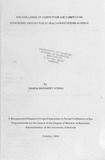| dc.contributor.author | Atieno, Banda M | |
| dc.date.accessioned | 2013-05-10T12:40:41Z | |
| dc.date.available | 2013-05-10T12:40:41Z | |
| dc.date.issued | 2006 | |
| dc.identifier.citation | A management research project submitted In partial fulfillment of the requirements For the award of masters of business Administration (mba) degree school of Business, university of Nairobi. | en |
| dc.identifier.uri | http://erepository.uonbi.ac.ke:8080/xmlui/handle/123456789/21404 | |
| dc.description.abstract | The essence of formulating competitive strategy is to relate a company to its business
environment and enable it to cope with competition. Competitive strategy is therefore the
bases on which an organization or a business unit might achieve an advantage in its
market.
This study focused on the challenges of competition in the health sector industry with
emphasis on how the public health institutions are responding to these challenges in order
to meet their goal of providing accessible, affordable quality health care services to its
people. Previous scholars have concentrated on public health institutions and its health
care financing but have overlooked the issue of competition and how the Public health
hospitals are presently surviving to offer quality and affordable health services to their
patients in the face of this competition.
This study was designed to fill the gap by focusing on competition and how public health
hospitals survive this competition to achieve their goals. The study sought to answer the
following research questions: 1) what challenges do public health hospitals face from the
private health sector, 2) Which competitive strategies have the public health hospitals
adapted to counteract the private hospitals?
This study was conducted between October, 2005 and April, 2006. The design of this
study is a sample survey of public health hospitals in Kenya. The population of interest
therefore includes all public health hospitals in Kenya.
The sampling design (frame) included 1 national referral hospital, 2 provincial hospitals,
5 district hospitals and 4 health centres. This gives a total of 12 health institutions.
Data was collected using a semi-structured questionnaire comprising of 18 both openended
and close-ended questions. Primary data was collected using an interview guide.
IX
The questionnaire was divided into three parts. Part A comprised general information;
part B was comprised of questions that determines challenges from the environment and
part C were questions on the strategies used by the public health hospitals to response to
these challenges. Challenges were found to exist in the environment especially those from
the private hospitals. It was also found that the public health hospitals deployed strategies
to counteract these challenges. Both these were confirmed by mean scores of three and
above and percentages of fifty and above. | en |
| dc.language.iso | en | en |
| dc.title | The challenge of competition and competitive strategies used by public health institutions in Kenya | en |
| dc.type | Thesis | en |
| local.publisher | Business Administration and planning | en |

